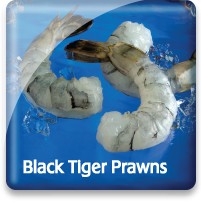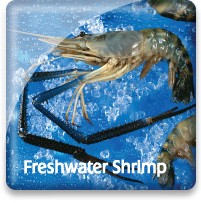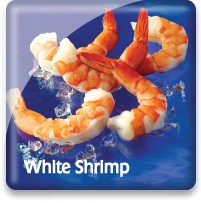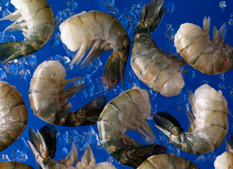
Freshwater Shrimp

Market Name: Eating QualitiesFreshwater Shrimp can be cooked in a variety of different culinary methods from boiling to barbecue and everything in-between. The cooked flesh tastes very much like lobster.
Female prawns can lay up to 250,000 eggs per year.
|
Description & CharacteristicsA seasonal treat, Freshwater Shrimp taste similar to lobster and are often served “head-on” as a “junior” or “baby” lobster. Ponds are seeded with post larval Freshwater Shrimp, Macrobrachium rosenbergii, during the monsoon season in Southeast Asia, India, and Bangladesh (May through September). The major harvest of commerical sized Freshwater Shrimp occurs 100-120 days later in the fall followed by a secondary harvest occuring the following spring (March-May). This secondary (hold over) season usually produces larger sized shrimp. Known in the U.S. as Giant Freshwater Shrimp and Giant Freshwater Prawn, Macrobrachium rosenbergii is also known by the FAO name, giant river prawn. M. rosenbergii is the most successful commercial species of Freshwater Shrimp of the approximately 200 specimens in the Palaemonidae family. Most other tropical shrimp species are from the Penaeidae family. Giant Freshwater Shrimp are a very large species of shrimp capable of reaching over 12 inches in length and can weigh as much as 500 grams (17½ ounces). Their large, long claws can extend another foot or more. Freshwater Shrimp are a thick bluish-green to brown-gray shrimp found in fresh and brackish water, but also in some marine environments. Whole shrimp look impressive. Their natural range includes Southern Asia, the Malay Archipelago and Northern Australia. Capture or wild production of Freshwater Shrimp is now limited and mostly artisanal. Freshwater Shrimp run very large—as big as fewer than three pieces to the pound. The largest sizes are preferred in the U.S. Historically, Freshwater Shrimp have had the stigma of being inferior in quality compared to a saltwater shrimp and in terms of not holding up under certain cooking preparations such as boiling because their flesh was often times too soft. However, today this has all changed due to the implementation of HACCP practices throughout the processing plants that Sea Port sources from our Indo-Asia-Pacific suppliers. These HACCP mandated controls to assure product safety have transformed the overall quality of Freshwater Shrimp and have rectified the occurrence of soft flesh. Sea Port Freshwater Shrimp now rightfully deserve the new reputation of being a truly delicious and versatile shrimp that is every bit as delectable as saltwater shrimp. Most Freshwater Shrimp available in the U.S. are produced by aquaculture. The top producers are India, Thailand, Bangladesh, Vietnam and there is some production in other parts of the world including the U.S.
Other Resources |
Handling Instructions for Freshwater Shrimp
Frozen Freshwater Shrimp should be stored at or below 0°F (-18°C) and then thawed properly when ready to cook. Our IQF Freshwater Shrimp have an 18-24 month frozen shelf life when stored properly. Links to proper seafood handling instructions: NOAA - Fish Watch: Handling Seafood and A Consumer Guide to Safe Seafood Handling.
Thawing Freshwater Shrimp
IQF Freshwater Shrimp should be quickly thawed by removing them from their package and placing them in a colander and running them under cold water until thawed. This method results in a high quality thawed shrimp that is immediately ready for cooking. Raw Freshwater Shrimp that is cooked immediately after proper thawing will yield the best quality.
Upon thawing, gently rinse with cold clean water. Shrimp that is not consumed promptly after thawing needs to be refrigerated between 33 and 39°F and must be consumed within 2-3 days.
Important Instructions for Freshwater Shrimp
The Federal Food, Drug and Cosmetic Act now requires that all foods that are not raw agricultural commodities and that contain a major food allergen be labeled to clearly identify the name of the food source form which the allergen is derived. (21 CFR U.S.C. 343(w)(1)). The act defines eight foods, and any ingredients derived from these foods as major food allergens: Fish, Crustacean Shellfish, Milk, Eggs, Tree Nuts, Peanuts, Wheat & Soybeans. The name of the food source that must be listed on the label for fish or crustacean shellfish must be the specific type of fish or crustacean shellfish. The market names of species of fish and crustacean shellfish should be used to identify the food source of these two major food allergens. If you intend to re-pack these seafood products, be sure the allergen is declared in either one of two ways:
1) Within the list of ingredients
or
2) In a separate “Contains” statement immediately after or adjacent to the list of ingredients.
Consult the Fish and Fishery Products Hazards and Controls Guidance, Fourth Edition, Chapter 19 for more detailed information on the labeling of food allergens.
Cooking Tips
Freshwater Shrimp and shrimp in general can be cooked in a variety of different culinary methods from boiling to barbecue and everything in-between. It is truly a multipurpose wonderfully healthy seafood that can brighten up a special celebration and also be served at regular meals throughout the week for the entire family. It is no wonder that shrimp is America’s most popular seafood. Links to cooking tips and recipes: Eat Shrimp and Receipes.
Thailand
With more than 1,550 miles of coastline, Thailand—officially, the Kingdom of Thailand—has become one of the world’s leading seafood suppliers. Primary seafood products from Thailand include cultured (farmed) shrimp sold in various value-added forms as well as canned seafood—predominantly tuna.
With a focus on constant improvement of shrimp farming techniques to reduce impacts on the environment, as well as the development of new, value-added products, Thailand has emerged over the years as one of the leaders in this beloved seafood category.
In the tuna category, Thailand is a major global producer of canned tuna, much of it caught by vessels from other countries that bring it, frozen, to Thailand to be canned.
Vietnam
With a coastline of 2,140 miles, as well as numerous rivers and lakes, Vietnam has had a long tradition of fishing and a culinary tradition that includes finfish, shellfish, and molluscan shellfish.
Bordering China in the far North, and Laos and Cambodia in the middle and Southern regions, the country—known officially as the Socialist Republic of Vietnam—is divided into 58 provinces, and includes several major sea ports.
With seafood production surpassing USD $6 billion in 2012, seafood—both cultured and wild—represents an important export for this developing country.
Major seafood exports from Vietnam include cultured and wild shrimp: Black Tiger prawns and Penaeus vannamei are grown in Southeast Vietnam, and small white and pink shrimp are still commercially caught in the South China Sea off the southern coast.
In addition, Vietnam is becoming known for its high-tech seafood processing industry, adding value to commercially harvested and farmed fish and seafood.
Species that are commercially caught include Grouper, Red Snapper, Red Mullet, Tuna, Swordfish, and Barramundi—which are the major species that are exported to Australia, the United States, and the EU. Vietnam is also a major producer of farmed Tilapia, and two species of Pangisius (boucourti and hypothalamus). Squid and octopus, as well as various species of lobster and crab and molluscan shellfish are also major export products as well as products consumed in-country.
India
The most populous democracy in the world, India has 1.2 billion people living in an area that is the world’s seventh-largest land mass. Bordering the countries of Pakistan, China, Nepal, Bhutan, Burma, and Bangladesh, India includes breathtakingly beautiful mountainous regions, plains, rivers (such as the legendary Ganges River), and valleys—and a coastline of 4,700 miles.
Within Indian marine waters, commercial species such as mackerel, sardines, shark, perch, tuna, shrimp, and cuttlefish are some of the main species harvested. Freshwater fish include carp and catfish and there are several species of brackish water fish.
India’s Exclusive Economic Zone (EEZ) encompasses more than 2 million square kilometer, so there is a huge potential within India, provided that the fishery is managed to thwart overexploitation of the resource.
Top export items from India include frozen shrimp (the dominant seafood export), and frozen lobster tails, to name a few.
Aquaculture in India is growing in importance, however, and in addition to producing carp and giant river prawn for in-country consumption, India has begun to grow and export warm brackish water shrimp as well.
Bangladesh
Located between India, the Bay of Bengal, and Burma, Bangladesh (also known as the People’s Republic of Bangladesh) is a low-lying country roughly the size of Iowa that is prone to extremes in climate—from drought to monsoons, with cyclones a regular occurrence. With as much as one-third of the country flooding every year during monsoon season, the country has been slow to develop and poverty continues to be a problem for the country.
However, international development agencies, governments, and NGOs have been making big strides in developing a viable aquaculture sector in Bangladesh. Finfish and shrimp are farmed in inland open waters, brackish waters, and the marine environment.
Although Bangladesh has a coastline of only 360 miles, it has extensive ponds, lakes, canals, rivers, and estuaries that total 4.6 million hectares. These water resources that can be, and are, used to cultivate seafood—primarily shrimp and some finfish species—for export. Fish and fishery products are, according to the United Nations Food and Agriculture Organization (FAO), the country’s third largest export commodity product. Farmed shrimp remains the most important seafood export. Today 75 percent of the shrimp exports from Bangladesh are farmed; 25 percent are wild. Other species that are exported are eels, crab, and some tilapia.
As a strategy to end poverty, Bangladesh today is working with international bodies to improve production techniques, conserve resources and species biodiversity, and develop a modern infrastructure for processing, marketing, and financing the industry.
Go Blue! Seafood Sustainability Spectrum*Click here for an explanation of our Sustainability Spectrum 
Sustainability AssessmentGenerally, Freshwater Shrimp farming has not resulted in some of the more concerning environmental impacts associated with early marine shrimp farming, such as mangrove loss. This is because, in part, they can be raised in freshwater, are more disease resistant, and must be raised in lower densities, resulting in less pollution than from more industrial farms. Sea Port’s Freshwater Shrimp are farmed in Bangladesh, India, Thailand, and Vietnam and the main farming practices in these four countries vary widely. In Bangladesh, India, and Vietnam, the shrimp are primarily raised in modified rice paddies, called “ghers” with few inputs, such as feed, or technology. In Thailand, the Freshwater Shrimp can be raised in ponds using innovative technology and inputs, such as feed. Each system has its pros and cons, but both have room for improvement in order to become more environmentally responsible. The Bangladeshi, Indian, Vietnamese, and Thai industries are constrained by larval seed supply, disease and some pollution. These issues are more challenging in Bangladesh, India, and Vietnam, since Thailand has access to more technology. The more industrial production in Thailand adds increased risk of pollution and an overuse of marine resources, but as best aquaculture practices steadily advance, these risks will be reduced over time. Today, there is more of a universal adherence to established best aquaculture practices. Such advances have greatly reduced the negative environmental impacts associated with Freshwater Shrimp aquaculture in terms of protecting the surrounding ecosystems from farm effluents and conserving their productive natural resources that are used as farm inputs. In addition, the growth in sustainable aquaculture certification schemes such as BAP, ASC, and GlobalG.A.P. have collectively helped drive these and other best practices toward greatly improving the environmental and socioeconomic sustainability of Freshwater Shrimp farming. The Monterey Bay Aquarium Seafood Watch program lists farmed Freshwater Shrimp from Asia as a "good alternative" because of their low environmental impact (generally less than those of white and black tiger shrimp farming). Shrimp recirculating aquaculture systems (RAS) in which the water and wastes are continuously filtered and recycled in order to conserve on inputs and nearly eliminate the effluents are seeing steady technological advancements and offer great promise for making shrimp aquaculture even more sustainable in the years to come. These RAS systems could be located nearer to markets around the world and hence help reduce the carbon footprint associated with transporting to markets. 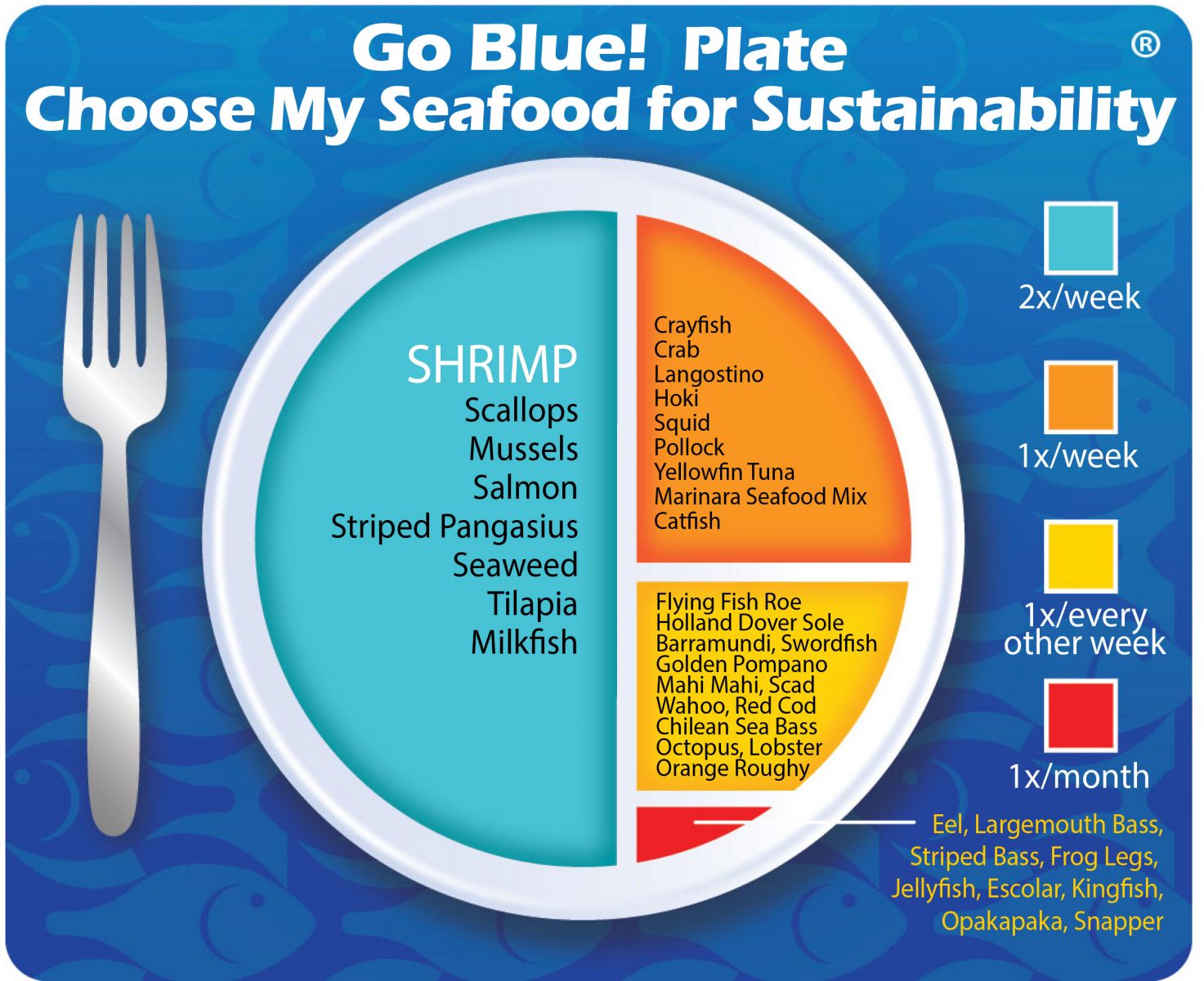 Environmental Impact: Low to ModerateThe low technology Bangladeshi, Indian, and Vietnamese industries are challenged with potential disease problems, pollution from other industries, and larval supply challenges. Industry also must monitor and reduce the risk of misuse of chemicals and social issues. The Thai industry is more technologically developed but is also more industrial, leading to greater potential issues of pollution and an overuse of marine resources used in feeds. However, if good aquaculture practices are continuously improved these risks will abate over time.
Sustainability Improvements NeededCollectively, farms need to improve practices, mitigate environmental impacts, and use resources more responsibly. The Bangladeshi, Indian, and Vietnamese industries need to focus on improving hatchery-raised larvae supply and quality in particular. The Thai industry needs to focus on reducing waste and becoming more feed efficient.
Actions that Sea Port is UndertakingSea Port is increasingly sourcing from Freshwater Shrimp processors and farms that are participating directly with the Global Aquaculture Alliance to improve the sustainability of their feed, hatchery, grow out, and processing operations. These processors and farms have either achieved the Global Aquaculture Alliance’s BAP certification (Best Aquaculture Practices) or are on the pathway to do so. Sea Port is a Premier Member of the Global Aquaculture Alliance and is dedicated to promoting aquaculture as the most environmentally responsible protein production system to feed our growing world population. Shrimp is the 1# consumed seafood in the U.S. Sea Port believes that, in aggregate, choosing from a diverse variety of seafood is better for sustaining the world’s seafood resources and Farmed Freshwater Shrimp should be a part of this variety. We created the sustainability assessments for each of our seafood items in order to reveal the existing and potential environmental impacts and risks that are associated with producing them for human consumption. This allowed us to establish the starting position for each of our seafood items along our progressive Go Blue! Seafood Sustainability Spectrum®. These assessments are only a single snapshot in time and because of this, we will continue to assess and update the critical sustainability needs associated with our supply sources and issue updates to the Go Blue! Seafood Sustainability Spectrum® as needed. There is a growing global awareness for the need to assure the sustainability of farmed and wild caught seafood and because of this; all around the world positive changes are rapidly occurring at all levels of the seafood supply chain. We will continue to spread this growing awareness and work with our many industry partners to improve the sustainability of all seafood, which we believe is the ideal protein of choice to feed an ever growing world population. Our Go Blue! Seafood Sustainability Spectrum® serves as our compass and yardstick as we strive to move all our products forward to becoming more sustainable. Please join us in this committed quest and Catch Our Wave® to sustainability by choosing a diverse variety of responsibly produced seafood as part of your diet at least twice a week.
|


